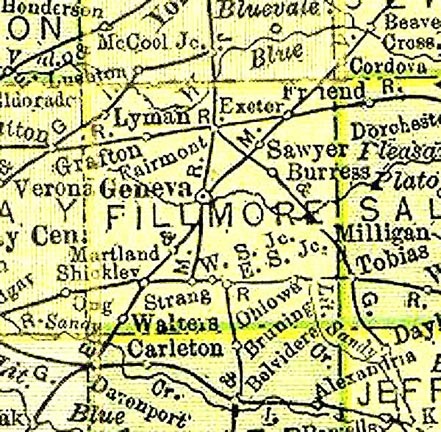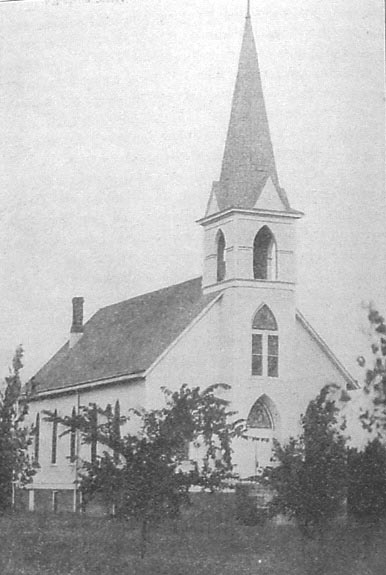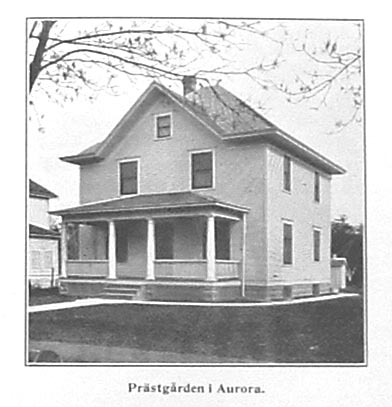C.R.Osbäck, in his "Minnes Album, Svenska Baptisterna i Nebraska 1869-1919" , reminds us that the Hordville Baptists trace their history to the same time as those over in Polk County, and name C.H. Lundgren as their mission founder. (1873-4) At that time the name of Hordville was yet in the future, their community was nearby and was called Stark. A memorable gentleman, Enoch Ekstrand, pointed out to us the spot on the road between Polk and Hordville where Stark had been, and noted that his ancestors lived in a sod house there. (We were among the many newcomers to Stromsburg who were recipients of one of Enoch's welcoming angel food cakes.) In its early days it was served by farmer-pastors named Chader and Palm. In 1886 the group advanced from meeting in homes or schools to a church of its own. The days of the Baptist seminary in Stromsburg provided a source of student pastors; named are Necker, Berggren, Nyleen and Törnquist. The last-named returned for three periods of service at Hordville totalling more than a decade. C.A. Anderson had a pastorate of just over eight years as well, making this church a remarkably stable one. In 1921, the church was moved to the railroad townsite of Hordville and took up its new name.

Hordville Swedish Baptist church
If we take strictly the boundaries of Hamilton County, we look in vain for evidence of a Swedish Augustana Lutheran presence. From the early days when their Nebraska and Kansas conferences were joined, there were places near the southern part of Hamilton County where Lutheran churches are found. Stockholm church between Shickley and Ong, Saronville, and Gethsemane at Ong (where Peter Wedin served) are over in Clay and Fillmore Counties, near the Burlington railroad. The Swedish Methodists were also present in these areas and are mentioned as direct competitors with the early Lutheran efforts there. A mission preaching station is also found in this area, known as Verona (Swedish Vråna?). Swedish journalist O.M. Nelson produced two little books that are valuable to us. "Svenskarna I Nebraska" and "Svenskarna I Iowa". A brief summary of the Swedish settlements county by county is offered, with care to include each church. Some denominational histories mention preaching stations with obscure names and vague outcomes; Nelson helps to pin down some of these places.
Verona is a good example. In the story of the Saron Augustana church, Saronville, Clay County, Sandahl reports that their pastor A.G. Freden "who first served a Mission church in Verona, a few miles from Saronville" came in 1888.
In the 1934 record of "The Conference of the Evangelical Free and Independent Churches of Nebraska," part of the Golden Jubilee book, an evangelistic tent meeting is reported at Verona in 1910. We have elsewhere associated state evangelist C.O. Sahlstrom with this location.
But C.R. Osbäck is more revealing. As early as 1876, he reports that C. Lundgren, one of the earliest pastors of Swede Home church in Polk County, came down to Verona to preach there. Lundgren, remember, switched allegiance to the Baptist faith and became the first Baptist pastor in Stromsburg. In that year he organized a church of twenty members, sixteen of whom were newly baptized. By 1888 the membership was up to thirty-five, but the "holiness" movement came to cause problems. Baptist conference leaders attempted to restore order, but with characteristic firm discipline, expelled Verona from their ranks in 1891. Duly repentant, they were readmitted the following year, but seem to have languished.
Thanks to Nelson, we can pinpoint the location: seven miles southeast of Sutton on the Burlington railroad (watering stations are seven miles apart on the railroads of steam days). In 1927, a little Swedish church stands in the town but its work is "at a standstill." "Holiness" was the description of C.O. Sahlstrom's emphasis in Princeton, Illinois as well. We are never sure whether this relates more closely to the "sanctification" or "second blessing" associated with the Jonas Hedstrom Swedish Methodists, or the charismatic phenomenon of the August Davis "Free-free". What remains of Verona lies in fascinating obscurity.

early map with vague location of Verona
* * *
To the north the strong influence of the Swede Home church in Polk County accounted for the only early Augustana congregation in Hamilton County, the Fridhem congregation of Hordville. This group began among a few Swedes who did not find the local Swedish Baptist congregation to their liking and sought out the Swede Home pastor to begin holding meetings in Hordville. The effects of this are reflected in the decline of membership in the Baptist congregation from forty-eight in 1889 to twenty-five in 1899.
When the railroad came through the area it did not bypass Hordville and that no doubt did much to contribute to the viability of the church. (in fact it was a "railroad town") Sandahl reports that the town itself was laid out on Augustana's land. No doubt there were other pro-Lutheran immigrants to Hamilton County, but as was the case in the northern tier of Phelps County, the temper of the times among the immigrants of those particular years, and the influence of the Swedish land agents such as Hallgren and Rylander, accrued to the benefit of the "free" mission friends. So we have Baptist, Methodist and Mission churches, but only one Augustana congregation.

Hordville Fridhem Lutheran: another satellite of Polk County
A local online historian has provided the interesting facts that when a new Lutheran church was built in Hordville, "the original church building was moved to the main street in 1908 and used as an opera house and town hall. " The same source reveals that a Methodist church was built in 1907 and continued to operate till 1955. Clarence Rodin, brother of this writer's grandmother and of Free Pastor Hugo Rodin, was manager of the Hordville grain elevator for many years.
Today the prominent city of Hamilton County is Aurora, where two churches of Swedish background are found: the Covenant and the Free. We have looked at the early settlements just to the north of Aurora and now we turn to developments within the town itself.
One of the names associated with the Aurora Mission Friends is the layman D.A. Johnson. He has come from Michigan, and owns a prominent clothing store. This is illustrative of a general distinction between the earlier immigrants and those of the time that Aurora's church was founded. The former were "tailors" apprenticed in Sweden and homesteaders on farms; now we have businessmen coming to operate stores in railroad towns. A new era is already dawning.
To understand the circumstances of this changing era is not easy. There are many ingredients to the mixture. The center of gravity of communities is pulled by the railroad towns. Time and again, the earlier centers decline and the station towns grow and prosper. A business in a railroad town demands familiarity with the English language, and the population is of mixed ethnic origins.

The Mission Church of Aurora
For a new church to begin in this context could not have been easy. It is a credit to the founders of the Aurora church that they were able to navigate through this to a successful conclusion. Those founders were surely aware of the division in the rural settlements to the north between the Mission Synod and the Free Mission people. As in other places, their solution was to base their organization on the "independent" principle; one that might satisfy both parties. For the moment this seemed to work.
The matter of pastoral leadership presented its own set of problems. Some of the early visiting pastors must have presented a variety of perspectives. "Old Mellen", who is described as a Swedish colporteur type from Lake Station, Indiana, spent a brief time there. It was characteristic of this "type" to come and go quickly. Then C.A. Falk from Stromsburg is mentioned. His family settled in Fremont county Iowa; he had Augustana and Ansgar backgrounds. Then comes C.G.F. Johnson, who figured prominently in the Newman Grove Free church history. It is truly difficult to imagine what different impressions these various men might have left on the Aurora faithful. It would be gratifying to think that a unifying gospel bound each of their messages together for their ultimate benefit.
The question of a physical facility also presented itself. Their first meeting place was an American Baptist church, which soon itself became a United Brethren congregation. Having outgrown this building, the Mission Friends now accepted the hospitality of the United Evangelical church, which was "more central." They relied on a joint pastorate with Siloa; veteran Mission Synod pastor Göran Norsen, followed by Emmanuel Berg. Siloa had a parsonage which solved the problem of accommodations for the pastor.

The Parsonage: still in 1912 called "prästgård","priesthouse"
With Berg at the helm, the congregation aspires to encorporate itself under a more formal structure and build its own house of worship. In 1906, North Park graduate F.O. Gustafson arrives as the new pastor at the new church; soon to have its own proper parsonage. Retiring farmers from the north settlements provide a steady source of new members as they "move to town". The declining Siloa congregation graciously provides their old parsonage as a dwelling for Norsen's widow. The Aurora congregation gradually emerged from cautious independence to full and fruitful participation in the Covenant denomination. A new building and parsonage stand at Aurora's western edge.
At some point, a Free Mission congregation also formed in Aurora, but the 1934 Free church history has no information about this. This congregation also now worships in a newer facility.